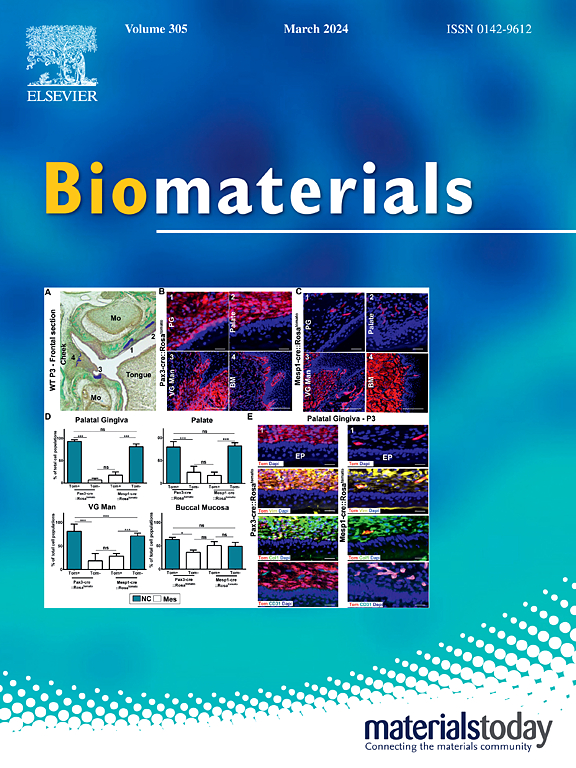以透明质酸为生物活性纳米载体的多功能可注射生物材料的研制
IF 12.9
1区 医学
Q1 ENGINEERING, BIOMEDICAL
引用次数: 0
摘要
基于透明质酸的生物材料由于在糖胺聚糖分子中包含多个生物活性结构域而提供了多种功能。这一特性对于治疗中枢神经系统损伤的再生策略尤其有希望,中枢神经系统损伤是一个复杂的系统,需要组合方法来解决不同的机制。本研究将转化生长因子β (TGF-β)信号的小分子抑制剂sb431542和排斥性引导分子a (RGMa)拮抗剂肽偶联到基于透明质酸的纳米载体上,以同时解决损伤微环境的多个方面。将改性的透明质酸与热响应性聚合物水凝胶poloxam407配对,以创建可注射的递送系统。可注射平台的合成、表征和验证表明,其机械性能与先前用于中枢神经系统的支架相当,具有生理上相关的货物释放率,以及在三维体外模型中调节细胞功能的能力。在颈级脊髓半切损伤动物模型中进行的概念验证研究表明,在交付水凝胶后,宿主轴突和星形胶质细胞在病变内的浸润增加。此外,损伤后8周对损伤部位的红脊髓束和网状运动束的追踪表明连通性有所改善。总的来说,本研究建立了结合不同生化成分构建异功能纳米载体的效用,并证明了同时处理损伤反应的多个方面有可能恢复中枢神经系统的连通性。本文章由计算机程序翻译,如有差异,请以英文原文为准。

Development of a multifunctional, injectable biomaterial using hyaluronan as a bioactive nanocarrier
Hyaluronic acid-based biomaterials provide diverse functionality due to the inclusion of multiple bioactive domains within the glycosaminoglycan molecule. This attribute is particularly promising for regenerative strategies to treat central nervous system injury, which is a complex system that requires combinatorial approaches to address different mechanisms. Here, a small molecule inhibitor of transforming growth factor β (TGF-β) signaling, sb431542, and repulsive guidance molecule A (RGMa) antagonist peptide are conjugated to the same hyaluronan-based nanocarrier to simultaneously address multiple aspects of the injury microenvironment. The modified hyaluronan is paired with a thermo-responsive polymeric hydrogel, poloxamer 407, to create an injectable delivery system. Synthesis, characterization, and validation of the injectable platform demonstrates mechanical properties on par with previous scaffolds used in the central nervous system, physiologically relevant release rates of cargo, and the ability to modulate cellular function in a three-dimensional in vitro model. Proof of concept studies in a cervical-level hemisection spinal cord injury animal model indicate increased infiltration of both host axons and astrocytes within the lesion following delivery of the hydrogel. Additionally, tracing of rubrospinal and reticularmotor tracts across the site of injury eight weeks post-injury suggests improvements in connectivity. Overall, this study establishes the utility of combining different biochemical moieties to build heterofunctional nanocarriers and demonstrates that treatments simultaneously addressing multiple aspects of the injury response have the potential to restore connectivity in the central nervous system.
求助全文
通过发布文献求助,成功后即可免费获取论文全文。
去求助
来源期刊

Biomaterials
工程技术-材料科学:生物材料
CiteScore
26.00
自引率
2.90%
发文量
565
审稿时长
46 days
期刊介绍:
Biomaterials is an international journal covering the science and clinical application of biomaterials. A biomaterial is now defined as a substance that has been engineered to take a form which, alone or as part of a complex system, is used to direct, by control of interactions with components of living systems, the course of any therapeutic or diagnostic procedure. It is the aim of the journal to provide a peer-reviewed forum for the publication of original papers and authoritative review and opinion papers dealing with the most important issues facing the use of biomaterials in clinical practice. The scope of the journal covers the wide range of physical, biological and chemical sciences that underpin the design of biomaterials and the clinical disciplines in which they are used. These sciences include polymer synthesis and characterization, drug and gene vector design, the biology of the host response, immunology and toxicology and self assembly at the nanoscale. Clinical applications include the therapies of medical technology and regenerative medicine in all clinical disciplines, and diagnostic systems that reply on innovative contrast and sensing agents. The journal is relevant to areas such as cancer diagnosis and therapy, implantable devices, drug delivery systems, gene vectors, bionanotechnology and tissue engineering.
 求助内容:
求助内容: 应助结果提醒方式:
应助结果提醒方式:


